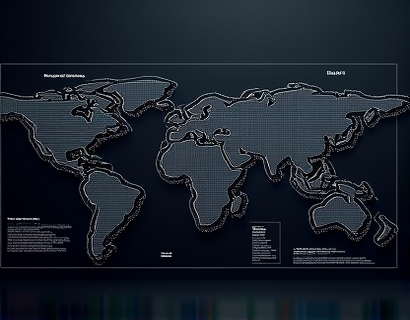Maximizing Multi-Chain Token Management: A Complete Guide for Blockchain Optimization and Performance
In the rapidly evolving world of blockchain technology, managing tokens across multiple chains effectively is crucial for maximizing performance and ensuring seamless operations. This guide aims to provide blockchain professionals and token managers with essential tools and strategies to optimize token management across diverse blockchains. From creation to tracking and optimization, this comprehensive resource will equip you with the knowledge needed to enhance your token's efficiency and performance in the dynamic crypto landscape.
Understanding Multi-Chain Token Management
Multi-chain token management involves overseeing tokens that operate on different blockchain networks. Each blockchain has its unique characteristics, consensus mechanisms, and smart contract frameworks, which can impact token functionality and performance. Understanding these differences is the first step in effective multi-chain token management. Token managers must be aware of the specific requirements and limitations of each blockchain to design tokens that leverage the strengths of each network.
Key Considerations for Multi-Chain Tokens
- Blockchain Compatibility: Ensure the token design is adaptable to various blockchain environments, considering factors like gas fees, transaction speed, and smart contract capabilities.
- Interoperability: Implement solutions that allow tokens to seamlessly move between different blockchains, enhancing liquidity and accessibility.
- Security: Prioritize robust security measures to protect tokens from vulnerabilities specific to each blockchain.
- User Experience: Design intuitive interfaces and processes to facilitate user interaction across multiple chains.
By addressing these considerations, token managers can create tokens that not only function well on individual blockchains but also offer a cohesive experience across multiple networks.
Creating Multi-Chain Tokens
The creation process for multi-chain tokens involves several critical steps. First, define the token's purpose and functionality. Determine whether the token will serve as a utility token, security token, or a combination of both. This definition will guide the technical implementation and regulatory compliance.
Next, choose the appropriate blockchain(s) for token deployment. Ethereum remains a popular choice due to its mature ecosystem and extensive developer community, but other blockchains like Binance Smart Chain, Solana, and Polkadot offer compelling alternatives with lower fees and faster transaction times. Consider the trade-offs between security, scalability, and cost when selecting target blockchains.
Smart contract development is a pivotal aspect of multi-chain token creation. Utilize programming languages like Solidity for Ethereum or Plutus for Polkadot to write secure and efficient smart contracts. Implement features such as token transfer, staking, and voting, ensuring they are optimized for the chosen blockchains. Conduct thorough testing to identify and rectify any potential issues before deployment.
Cross-Chain Bridges and Atomic Swaps
To enable seamless token movement between blockchains, leverage cross-chain bridges and atomic swaps. Cross-chain bridges facilitate the transfer of tokens from one blockchain to another, while atomic swaps allow for direct token exchanges without intermediaries. These technologies enhance liquidity and accessibility, making multi-chain token management more efficient.
When selecting a cross-chain solution, evaluate factors like reliability, security, and compatibility with target blockchains. Popular cross-chain protocols include Polkadot's XCM and Cosmos's IBC. Implementing these solutions requires careful planning and integration to ensure smooth token transfers.
Tracking Multi-Chain Tokens
Effective tracking of multi-chain tokens is essential for monitoring performance, ensuring security, and maintaining user trust. Utilize blockchain explorers and analytics tools to monitor token transactions, balance distributions, and smart contract interactions across different blockchains. These tools provide real-time insights and help identify potential issues promptly.
Implement a centralized dashboard that aggregates data from multiple blockchains, offering a unified view of token activities. This dashboard should include features like transaction history, balance tracking, and alert notifications for unusual activities. By centralizing tracking capabilities, token managers can respond quickly to any anomalies and maintain optimal performance.
Data Integration and Analysis
Integrate data from various sources to gain comprehensive insights into token performance. Utilize APIs provided by blockchain explorers and third-party analytics platforms to collect and process data. Advanced analytics tools can help identify trends, user behavior, and market dynamics, enabling data-driven decision-making.
Focus on key performance indicators (KPIs) such as token supply, transaction volume, and user engagement. Monitor these metrics across different blockchains to assess the token's overall health and identify areas for improvement. Regularly review and adjust strategies based on data-driven insights to optimize token performance.
Optimizing Multi-Chain Token Performance
Optimizing multi-chain token performance involves continuous monitoring, strategic adjustments, and leveraging emerging technologies. Here are some strategies to enhance token efficiency and user experience:
- Gas Optimization: Minimize gas costs on Ethereum by optimizing smart contract code and utilizing layer 2 solutions like Optimism or Arbitrum. This reduces transaction fees and improves user adoption.
- Scalability Solutions: Implement scalability solutions such as sharding or sidechains to handle high transaction volumes and ensure smooth operations across multiple blockchains.
- User Interface Enhancements: Develop intuitive and responsive user interfaces that provide a seamless experience across different devices and blockchain environments.
- Community Engagement: Foster a strong community around the token to drive adoption and gather feedback for continuous improvement.
Stay updated with the latest blockchain advancements and integrate innovative technologies to maintain a competitive edge. For instance, exploring the use of decentralized finance (DeFi) protocols can unlock new opportunities for token utility and growth.
Regulatory Compliance and Risk Management
Navigating the regulatory landscape is a critical aspect of multi-chain token management. Different blockchains and jurisdictions have varying regulations regarding tokens, especially security tokens. Ensure compliance by staying informed about local and international regulations and implementing necessary measures to adhere to legal requirements.
Conduct regular risk assessments to identify and mitigate potential vulnerabilities. Implement robust security protocols, such as multi-signature wallets and regular audits, to protect token assets. Transparency and clear communication with users and stakeholders are also essential in building trust and managing risks effectively.
Conclusion
Maximizing multi-chain token management requires a comprehensive approach that encompasses creation, tracking, optimization, and regulatory compliance. By leveraging the right tools and strategies, blockchain professionals and token managers can enhance token performance and navigate the dynamic crypto landscape with confidence. This guide provides a solid foundation for optimizing multi-chain token management, empowering you to achieve success in the ever-evolving world of blockchain technology.










































